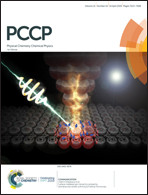Ionic structure and transport properties of KF–NaF–AlF3 fused salt: a molecular dynamics study
Abstract
We used the first-principles molecular dynamics simulations combined with the interatomic potential molecular dynamics to study the ionic structure and transport properties of KF–NaF–AlF3 fused salt. Simulation results show that the ionic structure of KF–NaF–AlF3 fused salt is principally dominated by the distorted five-coordinated [AlF5]2− and six-coordinated [AlF6]3− groups. When melting to a liquid, a part of the six-coordinated [AlF6]3− group dissociated into the four-coordinated [AlF4]− and five-coordinated [AlF5]2− groups. Four, five and six-coordinated aluminum–fluoro complexes coexist in KF–NaF–AlF3 fused salt, while the tetrahedral [AlF4]− groups are relatively rare. The content of the bridging fluorine atom is relatively small, about 5–11%, which indicates that the polymerization degree of the ionic structure of the KF–NaF–AlF3 fused salt system is lower. The KF–NaF–AlF3 fused salt has better liquidity and ionic conductivity due to the high self-diffusion coefficients of all particles in the fused salt system. KF can effectively break the F atom bridges, which reduces the polymerization degree of the ionic structure of the fused salt system and increases its ionic conductivity.



 Please wait while we load your content...
Please wait while we load your content...